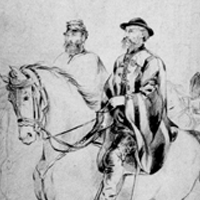Henri Lovie (1829-1875)

Lovie was born in Berlin Prussia in 1829. He immigrated to the United States and established himself in Cincinnati as a portrait and landscape painter, designer, and illustrator by the 1850s. He drew the illustrations for The Ohio Railroad Guide (Columbus, 1854), Zoe; or the Quadroon’s Triumph By Elizabeth Livermore (Cincinnati, 1855), Brother Mason, the Circuit Rider; or Ten Years a Methodist Minister (Cincinnati, 1855), The Gallows, the Prison, and the Poor-House by G.W. Quinby (Cincinnati, 1856). From 1856 to 1859, he and Charles Bauerle maintained an engraving company, and together they produced the illustrations for Man-of-War Life: A Boy’s Experience in the United States Navy(Cincinnati, 1856), The Merchant Vessel: A Sailor Boy’s Voyages to See the World Cincinnati, 1856), and The Book of the Great Railway Celebrations of 1857 (New York, 1858). He also taught drawing at Robert Conner's Cincinnati Academy of Design and at Cincinnati Wesleyan Female College, and he participated in the Cincinnati Sketch Club along with James Beard, T. Worthington Whittredge, Robert Scott Duncanson, and Henri Mosler. By 1860, Lovie was in New York where he joined Frank Leslie’s Illustrated Newspaperas a “special artist” and was sent in February 1861 to follow Abraham Lincoln from Springfield, Illinois to Washington D.C. for the presidential inauguration. Lovie joined General George McClellan’s army in Washington and produced panoramic views of the battle of Philippi and the West Virginia terrain. After the battle, he augmented his drawings by going onto the field to make sketches of battle debris, and he toured the Federal camp to interview and sketch soldiers. In June 1861, Lovie obtained permission to join the Federal Expeditionary Forces going up the Missouri River under the command of Brigadier General Nathaniel Lyons to capture Jefferson City and Boonville, the headquarters of the Missouri state militia. The campaign ended with a Union retreat after the Battle of Wilson’s Creek where Lovie recorded the death of General Lyons. Lovie escaped to Lebanon, Kentucky and then returned to Missouri, drawing scenes of battles at Munfordville, Kentucky and Stones River, Tennessee where he recorded the death of Colonel Julius Garesche. Leslie’s published 148 of Lovie’s wartime drawings. He returned to Cincinnati after the war but moved to Philadelphia in 1868 to complete a life-size bronze figure of a soldier, which stands as a war memorial in Springfield, Ohio. The Becker Collection contains drawings done by Lovie in West Virginia, Illinois, Missouri, Tennessee, Kentucky, Mississippi, Ohio, and Virginia between 1861 and 1863. See works by this artist.